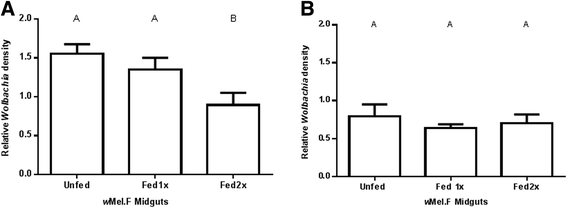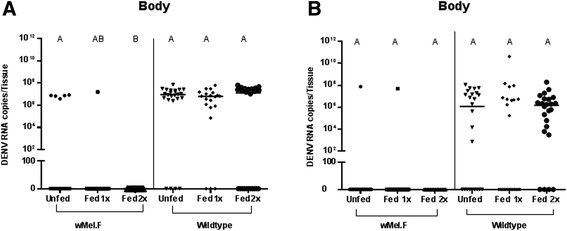Effect of repeat human blood feeding on Wolbachia density and dengue virus infection in Aedes aegypti
- PMID: 25903749
- PMCID: PMC4413987
- DOI: 10.1186/s13071-015-0853-y
Effect of repeat human blood feeding on Wolbachia density and dengue virus infection in Aedes aegypti
Abstract
Background: The introduction of the endosymbiotic bacterium, Wolbachia into Aedes aegypti populations is a novel approach to reduce disease transmission. The presence of Wolbachia limits the ability of the mosquito to transmit dengue virus (DENV) and the strength of this effect appears to correlate with Wolbachia densities in the mosquito. There is also some evidence that Wolbachia densities may increase following the consumption of a bloodmeal. Here we have examined whether multiple blood feeds lead to increases in density or associated changes in Wolbachia-mediated blocking of DENV.
Methods: The Wolbachia infected Aedes aegypti mosquito line was used for the study. There were three treatment groups; a non-blood fed control, a second group fed once and a third group fed twice on human blood. All groups were orally infected with DENV-2 and then their midguts and salivary glands were dissected 10-11 days post infection. RNA/DNA was simultaneously extracted from each tissue and subsequently used for DENV RNA copies and Wolbachia density quantification, respectively.
Results: We found variation between replicate vector competence experiments and no clear evidence that Wolbachia numbers increased in either the salivary glands or remainder of the body with feeding and hence saw no corresponding improvements in DENV blocking.
Conclusions: Aedes aegypti are "sip" feeders returning often to obtain bloodmeals and hence it is important to assess whether repeat blood feeding improved the efficacy of Wolbachia-based DENV blocking. Our work suggests in the laboratory context when Wolbachia densities are high that repeat feeding does not improve blocking and hence this ability should likely be stable with respect to feeding cycle in the field.
Figures







References
-
- WHO. Dengue: guidelines for diagnosis, treatment, prevention and control: New edition. Geneva: WHO press; 2009. - PubMed
MeSH terms
Grants and funding
LinkOut - more resources
Full Text Sources
Other Literature Sources
Medical
Miscellaneous

